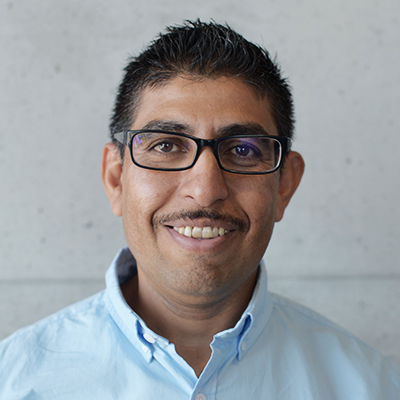Faculty Spotlight: Francisco Uviña
October 16, 2020 - Felina Maria de la Luz Martinez

Francisco Uviña is the Director of the Historic Preservation + Regionalism Certificate Program and a Senior Lecturer III in the UNM School of Architecture and Planning. His current research focuses on “earth architecture”, architecture constructed from earth and other natural mixtures. This includes predominantly historic earthen architecture that Uviña says we can learn much from.
“A colleague and friend in Mexico used to say that walls have a story to tell. That is how I feel about such structures. Even with little or no historical research, you can tell many things from a building,” Uviña said.
Born along the U.S-Mexican border, Uviña says he feels a close attachment to the history, food, culture, and music of Mexico.
“What really amazes me is the relationship of our architecture, urban typologies, and indigenous cultures. I mainly focus on earthen architecture and its preservation. This has led me to focus not just on Mexico, but other regions, such as Peru, where a rich history of earth construction exists,” Uviña said.
Uviña says this research allows him to experiment with soil mixes and examine the preservation of not just the material of the buildings, but the local tangible and intangible aspects in the art of making and building.
“That is why it is of great importance to keep as many of these older structures standing since they have something important to communicate. Besides the histories, it also speaks to a construction typology,” Uviña said.
Uviña has been working with Mexican colleagues now for over 25 years on the development of a series of workshops called Taller Internacional de Conservacion y Restauracion de Arquitectura de Tierra (TICRAT).
“The workshops are for community members, professionals, students and others to capture enough knowledge for them to value and disseminate the importance of traditional building technologies. For the restoration of these buildings, but also for the use in contemporary buildings,” Uviña said.
Uviña says this initiative started in the mid-1990’s and is in collaboration with colleagues in Mexico at Instituto Nacional de Antropologia e Historia (INAH) and the US National Park Service. The next of these workshops will take place before the Terra 2022 Congress in Santa Fe, New Mexico.
While Uviña says historic preservation is important, he is also interested in the construction of contemporary buildings with the use of traditional technologies.
“What really interests me about contemporary architecture is how we can implement design techniques and concepts, and apply them with the use of traditional earthen technologies. I truly believe in preserving past styles and protecting them for our future generations, however, it is different when applying it to our present context and way of living. The material palette and technologies nowadays are so abundant and require for us, the designers and builders, to apply some of these ideas to our contemporary architecture. I’m not a big believer of stabilized earth products but, in using traditional methods of construction, we can propose better designed structures and details,” Uviña said.
Currently, Uviña says he is focusing on a variety of projects including the development of the Georgia O’Keeffe Cultural Landscape Report. This project, led by Julie McGilvray with the National Park Service, aims to document the history, significance, and treatment of different sites, and landscapes where O’Keeffe spent most of her years painting and living.
“The long term idea is to continue working on different sites where Georgia spent most of her years painting and living in order to construct a publication on Georgia O’Keeffe’s landscapes. The next class this coming summer will explore the Ghost Ranch site which is a spectacular site and where Georgia lived part of the year while in New Mexico,” Uviña said.
When it comes to young scholars in the field of Latin America, Uviña says his advice is to find a niche and learn the language.
“First off, I congratulate them because there is no other place on earth as rich in culture as Latin America. The variety of things to study is amazing. Explore, if you haven’t yet! Find a niche, what really appeals to you and follow that dream. One thing and an important one is you need to learn the language in order to understand customs and culture, and if you are diving into an indigenous culture, be respectful and really try hard to learn their language and their ways. Our university has amazing resources that can be accessed for this,” Uviña said.
